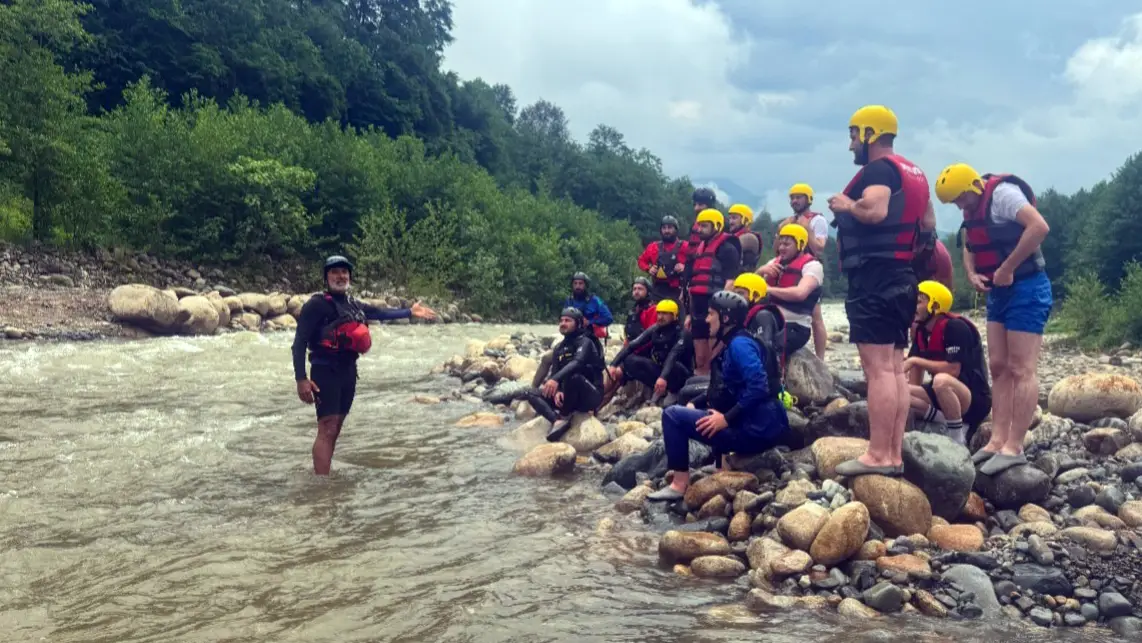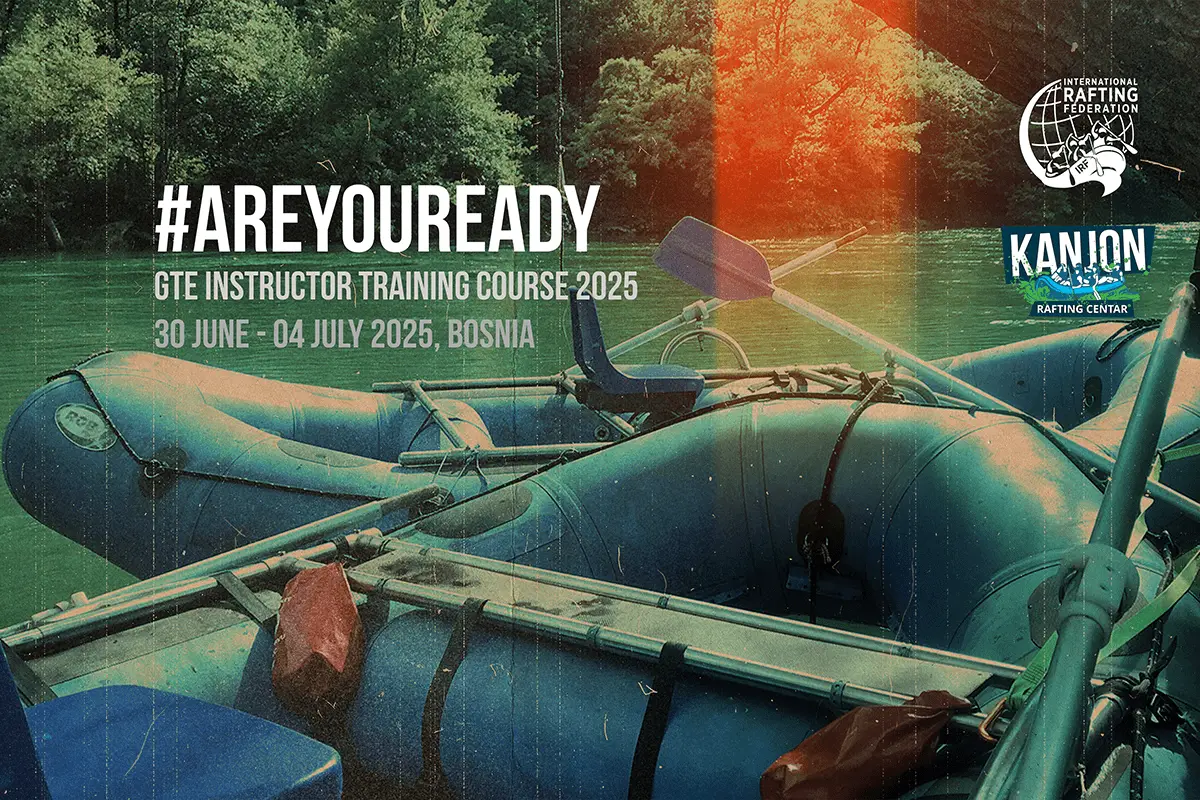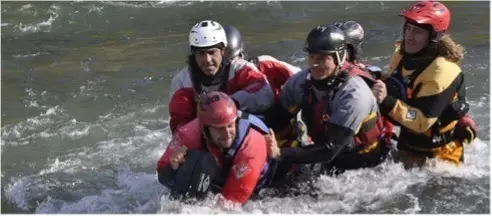Notes from a IRF GTE workshop in Russia

One thing I have observed over the years is that all great white water stories normally start with the sentence “This crazy Russian paddler … ” or “Crazy Russian inner-tube rafts.” I sat back and giggled to myself as my short flight from Helsinki touched down at St Petersburg Pulkovo airport in Russia. I was about to find out first hand if this was true or not.
My mission this week was to observe and assist in the running of the first IRF workshop in Russia for over 15 years.
For the past few seasons I have been mentoring Russian kayaker Anton Sveshnikov along the pathway to become Russia’s first IRF Instructor. The first time I met Anton was a few years back on the Zanskar River in India where I was running a workshop at the time. One of the first things that struck me about Anton at the time was he was Russian and not crazy. Since then myself and Anton have crossed paths many times and I have learned that not all Russian rafters & kayakers are crazy.
 Anton provisionally passed his IRF Instructor assessment in India last year. In keeping with the new IRF guidelines Anton needed to deliver a workshop under the supervision of an assessor. Fast forward a few months and we had a group of 8 raft guides from all over Russia ready to go. Some of the guides had flown for over 5,000km to join us whilst others had travelled by car for between 10-20 hours.
Anton provisionally passed his IRF Instructor assessment in India last year. In keeping with the new IRF guidelines Anton needed to deliver a workshop under the supervision of an assessor. Fast forward a few months and we had a group of 8 raft guides from all over Russia ready to go. Some of the guides had flown for over 5,000km to join us whilst others had travelled by car for between 10-20 hours.
The workshop was hosted by Kivineimi rafting. Sergi, Egor & Kostantin made us more than welcome in their awesome riverside camp.
The Kivineimi rapids are situated 115 km North of St Petersburg. The 300m long section acts as the drainage between 2 lakes & creates a short but intense big volume 800 cumec Class 3 run with easy logistics.

The rapid ends in a lake which created some very interesting (raft eating) whirlpools to keep us on our toes.(Imagine 800 cumecs hitting stationary water).
Anton’s job was originally to run the safety kayak section of the workshop. In order to avoid any language problems I was more than happy to let Anton lead the way with the entire workshop.
Day 1 kicked off with introductions & personal kit inspections. I could see the students had many questions that needed answering. My job was to let the students warm to me so that they felt easy asking what they thought were stupid questions (which they were not!). Most if not all of the students were attending a structured course for the first time and having somebody observing them and giving them feedback on their performance was welcomed.
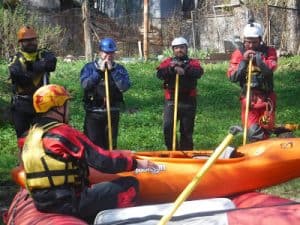
Before we headed to the water we decided to take a look at the pre trip safety demonstrations so we split into 2 groups, 4 guides with me & 4 guides with Anton.
A quick debate on how a foreigner who does not speak or understand Russian was going to asses their Russian safety talks soon followed.
Through Anton I explained that a good safety talk has no language barriers – actions speak louder than words.
The guides took a second to think about it and as a result we had some amazing safety demonstrations opposed to traditional boring, long winded, useless safety talks.
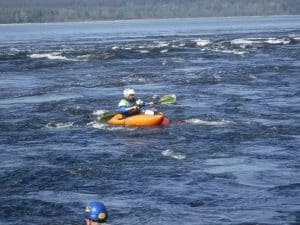
After a few warm up runs and a brief lesson in the understanding of Russian raft commands for my benefit we started seeing some impressive raft guiding skills. As the rapid was only 300m long the guides had to make the most of every ferry glide & eddy available to them. The rapid even had an eddy fed play hole which was great to observe surfing skills & crew management.
Day 1 was completed with a personal swimming skills assessment. I was happy to give demonstrations as Anton coached the students through the key points.
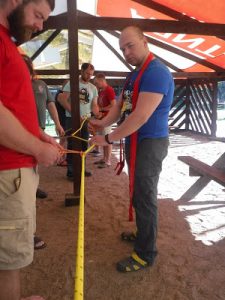
The students had a real motivation to make the final eddy on the swim test. Any student who missed the final eddy was heading towards the dreaded whirlpools!
The evening of day 1 ended with a foundation of knots and anchors section in preparation for the rope work test on day 3.
Day 2
During the 2nd or 3rd run on the 2nd morning. I realized that these guys were not crazy they simply did not have the same access to training that most western companies have.

These guys had really good on-water skills but some of their background knowledge & risk assessment skills needed topping up. The fact that they had taken the time to join the workshop showed that there is a real thirst for knowledge & education in Russia. The guide team were really starting to bond together.
Most Russians start there whitewater life as the crew in a cataraft. During the workshop I got to observe a father daughter team in training as we paddled on the rapids. I strongly recommend giving it a go if you get the chance. Paddling a cataraft is a good way to develop your water reading skills.
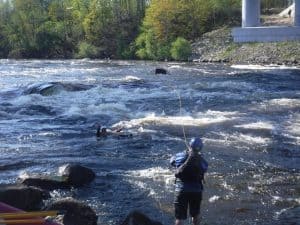 The afternoon of day 2 was spent looking at throwbag skills including the IRF throwbag test. The rapid gave us a perfect test site. The swimmers were moving in really fast water which meant that not only did the throw have to be accurate but the belay needed to be spot on. The guides showed us some excellent throwbag skills & techniques.
The afternoon of day 2 was spent looking at throwbag skills including the IRF throwbag test. The rapid gave us a perfect test site. The swimmers were moving in really fast water which meant that not only did the throw have to be accurate but the belay needed to be spot on. The guides showed us some excellent throwbag skills & techniques.
One of the key messages that was now becoming a mantra was practice, practice, practice. The guides were taking the course seriously. Knots were constantly been practised well into the night.
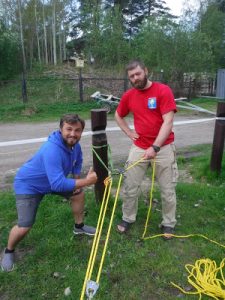 Day 3
Day 3
Day 3 or wobbly Wednesday as I like to call it started with a mechanical advantage rope-work test. After the first 2 days some of the guides were looking a little tired and wobbly on their feet. Myself & Anton had anticipated this and planned to stay on the land this morning.
Anton had assured me that all Russian men understand mechanical advantage as it was drilled into them at school. He was not wrong the standard IRF test was passed with ease.
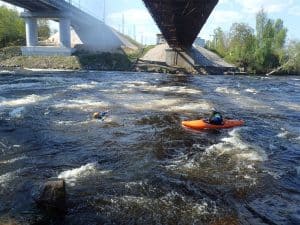 The remainder of the morning was dedicated to the art of safety kayaking. We spent time running the role of the safety kayaker on a commercial trip. We then gave the kayakers a multitude of tasks that involved controlling a guideless raft from their kayak & dealing with multiple types of swimmers. Each of the kayak students agreed that climbing from their kayak to the raft in the middle of a rapid was a challenging but fun exercise. The guides also mastered giving the kayak safety talk in silence which was impressive to watch.
The remainder of the morning was dedicated to the art of safety kayaking. We spent time running the role of the safety kayaker on a commercial trip. We then gave the kayakers a multitude of tasks that involved controlling a guideless raft from their kayak & dealing with multiple types of swimmers. Each of the kayak students agreed that climbing from their kayak to the raft in the middle of a rapid was a challenging but fun exercise. The guides also mastered giving the kayak safety talk in silence which was impressive to watch.
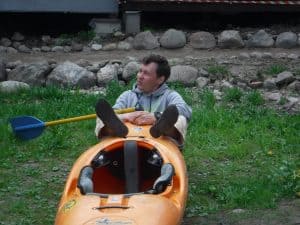
We were now moving into the time where we could potentially start to identify potential trip leader candidates. As this was the first workshop in Russia for a long time most of the students were either company owners or very experienced guides. Out of the group we identified 6 potential class 3 or class 2 trip leaders. Most of the students explained to me that one of the major challenges for a Russian raft guide is to take control of a crowd of rowdy Russian rafters. All of the candidates had very strong leadership capabilities. The nature of the Kivineimi rapid meant that all of the trip leader scenarios were going to be dynamic scenarios normally based around a flip. We ran scenarios focusing on lost customers, panicked swimmers, multi raft flips etc.
The final day was spent finishing off the trip leader scenarios which then moved into the Flip test. The lake proved to be ideal for flip drill testing. I lead the way with a demonstration then the guides followed with some impressive times in the sub 40 second range which is outstanding.
One of the things that struck me was the amount of support and positive energy that was flowing around the group.

By the time the Flip drills were over the group had bonded really well and you could see that some of them wanted to continue learning. Which is exactly what happened as the IRF workshop flowed straight into a 3 day Rescue 3 whitewater rescue technician course.
To sum the course up we had a blast. New friends were made. Russia has some new IRF guides and its first IRF instructor. Many thanks to Anton & the team from Kivineimi rafting for an amazing week of Russian hospitality.
Mark


